This historic Roman thoroughfare, named after Pope Julius II, was created in the early sixteenth century to connect the Vatican with the Ponte Sisto. It was long one of the city’s most fashionable streets, and wealthy citizens built impressive residences here.
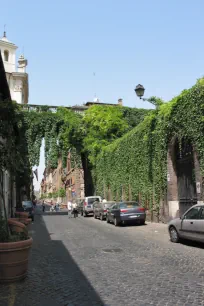
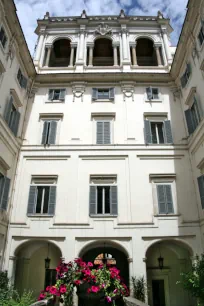
Its Construction
The Via Giulia is a road that was laid out by Donato Bramante during the reign of Pope Julius II, who ruled from 1502-1513. It is considered one of the city’s earliest examples of urban planning.
The miracle of Via Giulia is that it runs for a full kilometer in a straight line, a feat that was hard to accomplish in sixteenth-century Rome. Indeed, it was the widest, longest, and straightest street in the city at the time it was built.
Meant to make access to the Vatican easier, the street quickly became lined with elegant churches and palaces. And though the pope’s plans were only partially realized, it became an important thoroughfare, and a spot along the Via Giulia was long the prime choice of Roman aristocrats. Artists such as Raphael, Cellini, and Borromini made their homes along this expansive avenue and were joined by many others as the years passed by.
Julius II also commissioned Bramante with the construction of a massive central tribunal here, the Palazzo dei Tribunali. The ambitious complex, which was to become the street’s most impressive building, was however never completed. Large travertine blocks that formed the basis of the palace are now used as the foundation for houses and can be seen between the Via dei Bresciani and the Via del Gonfalone.
What to See
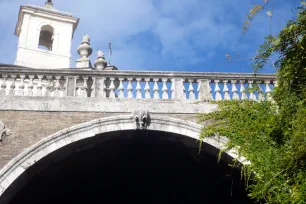
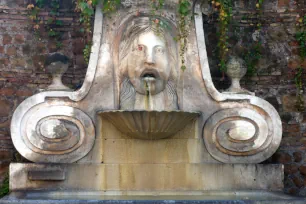
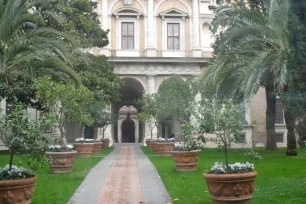
While many lavish parties were once organized in the Via Giulia – with at one point wine flowing out of the Mascheroni Fountain – today the street is very quiet.
Farnese Arch
Farnese Square, with the Villa Farnesina, located across the Tiber River. The arch across the Via Giulia, designed by Michelangelo, is the only section that was completed. Since the bridge over the Tiber was never constructed, the ivy covered arch serves no real purpose other than to embellish the street.
Fountain of the Mask
Nearby is the Fontana del Mascherone (Fountain of the mask), which was also commissioned by the Farnese Family. The curious looking fountain was created at around 1626 and replaced an earlier fountain. Its Renaissance design by Girolamo Rainaldi incorporates an ancient Roman granite bathtub and an ancient mask; the latter gave the fountain its name.
Farnese Palace
Through a gate, you can see into the garden of the Farnese Palace, one of the grandest palaces in Rome. It was built in the sixteenth century for Alessandro Farnese. Its interior is decorated with magnificent frescoes, including several created by the Bolognese painter Annibale Carracci, which are counted among the most impressive frescoes in all of Rome.
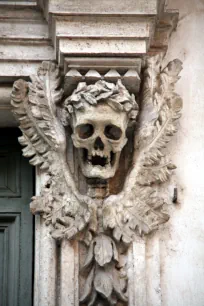
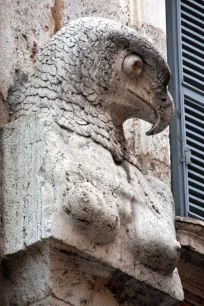
Santa Maria dell’Orazione
Across the street from the Farnese Palace is the Baroque Santa Maria dell’Orazione e Morte (Holy Mary of Prayer and Death Church), an unusual church which bears stone images of skulls on its doors. It once belonged to the confraternity that was charged with the task of burying unidentified dead.
Palazzo Falconieri
To the right of the church is the Palazzo Falconieri, a palace built in 1576 for the Odescalchi family. The property was acquired in 1637 by Orazio Falconieri, who asked architect Borromini to combine it with an adjoining building and create one large palace. Borromini completely refurbished the interior and rebuilt the facades, which he adorned with pilasters that end in falcon busts with female breasts.
Palazzo Sacchetti
More to the north of the street, at no. 66, is the Palazzo Sacchetti, one of the finest palaces in the street. It was built in the mid-1500s by the Sacchetti family to designs by Vasari. It is said that inside are some of the greatest state rooms in Rome. Outside, visitors can photograph its grand stone portal.
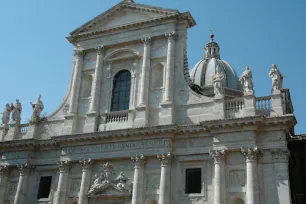
San Giovanni dei Fiorentini
At the northern edge of the street is the San Giovanni dei Fiorentini, a church built in the early 1600s for the Florentine community in Rome. It is the result of a combination of ideas by rival architects Sansovino, Sangallo, and Maderno, each of whom added something to this ornate ecclesiastic structure.

